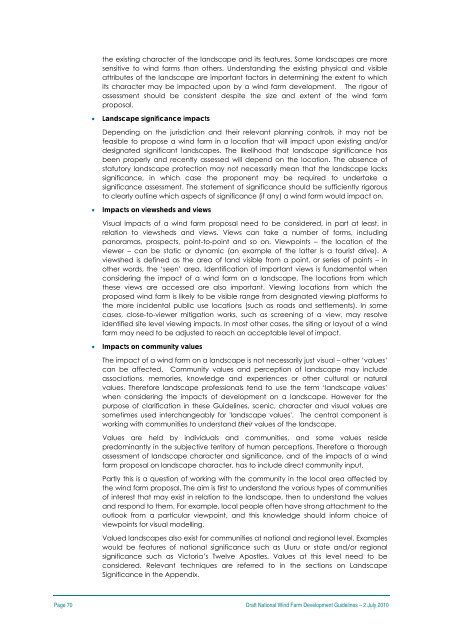Draft National Wind Farm Development Guidelines - July 2010
Draft National Wind Farm Development Guidelines - July 2010
Draft National Wind Farm Development Guidelines - July 2010
You also want an ePaper? Increase the reach of your titles
YUMPU automatically turns print PDFs into web optimized ePapers that Google loves.
the existing character of the landscape and its features. Some landscapes are more<br />
sensitive to wind farms than others. Understanding the existing physical and visible<br />
attributes of the landscape are important factors in determining the extent to which<br />
its character may be impacted upon by a wind farm development. The rigour of<br />
assessment should be consistent despite the size and extent of the wind farm<br />
proposal.<br />
• Landscape significance impacts<br />
Depending on the jurisdiction and their relevant planning controls, it may not be<br />
feasible to propose a wind farm in a location that will impact upon existing and/or<br />
designated significant landscapes. The likelihood that landscape significance has<br />
been properly and recently assessed will depend on the location. The absence of<br />
statutory landscape protection may not necessarily mean that the landscape lacks<br />
significance, in which case the proponent may be required to undertake a<br />
significance assessment. The statement of significance should be sufficiently rigorous<br />
to clearly outline which aspects of significance (if any) a wind farm would impact on.<br />
• Impacts on viewsheds and views<br />
Visual impacts of a wind farm proposal need to be considered, in part at least, in<br />
relation to viewsheds and views. Views can take a number of forms, including<br />
panoramas, prospects, point-to-point and so on. Viewpoints – the location of the<br />
viewer – can be static or dynamic (an example of the latter is a tourist drive). A<br />
viewshed is defined as the area of land visible from a point, or series of points – in<br />
other words, the ‘seen’ area. Identification of important views is fundamental when<br />
considering the impact of a wind farm on a landscape. The locations from which<br />
these views are accessed are also important. Viewing locations from which the<br />
proposed wind farm is likely to be visible range from designated viewing platforms to<br />
the more incidental public use locations (such as roads and settlements). In some<br />
cases, close-to-viewer mitigation works, such as screening of a view, may resolve<br />
identified site level viewing impacts. In most other cases, the siting or layout of a wind<br />
farm may need to be adjusted to reach an acceptable level of impact.<br />
• Impacts on community values<br />
The impact of a wind farm on a landscape is not necessarily just visual – other ‘values’<br />
can be affected. Community values and perception of landscape may include<br />
associations, memories, knowledge and experiences or other cultural or natural<br />
values. Therefore landscape professionals tend to use the term ‘landscape values’<br />
when considering the impacts of development on a landscape. However for the<br />
purpose of clarification in these <strong>Guidelines</strong>, scenic, character and visual values are<br />
sometimes used interchangeably for 'landscape values'. The central component is<br />
working with communities to understand their values of the landscape.<br />
Values are held by individuals and communities, and some values reside<br />
predominantly in the subjective territory of human perceptions. Therefore a thorough<br />
assessment of landscape character and significance, and of the impacts of a wind<br />
farm proposal on landscape character, has to include direct community input.<br />
Partly this is a question of working with the community in the local area affected by<br />
the wind farm proposal. The aim is first to understand the various types of communities<br />
of interest that may exist in relation to the landscape, then to understand the values<br />
and respond to them. For example, local people often have strong attachment to the<br />
outlook from a particular viewpoint, and this knowledge should inform choice of<br />
viewpoints for visual modelling.<br />
Valued landscapes also exist for communities at national and regional level. Examples<br />
would be features of national significance such as Uluru or state and/or regional<br />
significance such as Victoria’s Twelve Apostles. Values at this level need to be<br />
considered. Relevant techniques are referred to in the sections on Landscape<br />
Significance in the Appendix.<br />
Page 70 <strong>Draft</strong> <strong>National</strong> <strong>Wind</strong> <strong>Farm</strong> <strong>Development</strong> <strong>Guidelines</strong> – 2 <strong>July</strong> <strong>2010</strong>
















